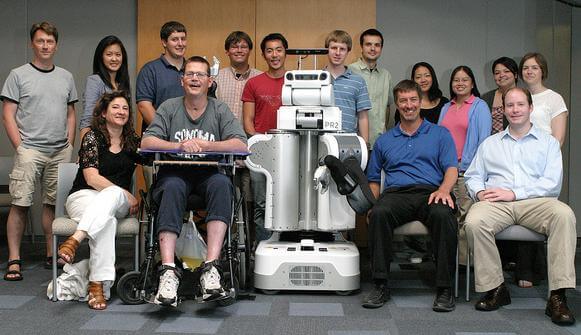
For ten years, Henry Evans couldn’t even scratch his nose. Now he has a $400,000 robot do it for him. A mute quadriplegic since his stroke at the early age of 40, Evans saw Georgia Tech’s Professor Charlie Kemp demonstrating a new robot on TV. It was the PR2 from Silicon Valley’s Willow Garage, and Evans decided he just had to get in on the action. Collaborating with the Healthcare Robotics Lab at Georgia Tech and Willow Garage, Evans has slowly gained a mastery of commanding the PR2. No easy feat considering he can only move his head and a single finger. With head tracking and simple controls Evan is able to command the robot to pick up items, drop them off, shave his face, and, yes, scratch his itches. Check out the amazing video below. Part of a new initiative called Robots for Humanity, the work done with Henry Evans hints at the awesome potential that the PR2, and personal robots in general, have to revolutionize the healthcare industry.
I’ve seen some pretty incredible projects in robotics, but Robots for Humanity is something very special. The tasks the robot performs may not seem extraordinary, but its the interaction with Henry Evans that really sets this program apart. Evans must be able to command the sophisticated PR2 with minimal input and somehow still achieve exactly the right outcome all while maintaining a work environment that is perfectly safe for both he and all the other humans in it. It’s a high wire walking act performed remotely using only head motions and a single finger, but the PR2 programming turns it into a cake walk. I can’t get enough of the smiles on the faces of Henry and his wife, Jane. Perhaps they’re catching a little glimpse of what their future could be.
As you see in the video, part of what makes the PR2 such a useful tool to Evans is its extensive library of autonomous behaviors. While he can move the robot’s grasping hand independently, the more impressive tasks (such as moving an object from one room to another) are done by initiating autonomous routines for navigation, object recognition, and grasping. The software for those self-guided actions is what makes healthcare robotics different (and potentially more practical in some cases) than robotic prosthetics. Some patients will be able to replace lost limbs with robotic appendages they can feel and command with their thoughts. Others will be able to augment their broken bodies with robotic exoskeletons. But for some patients, especially quadriplegics like Evans, a remotely controlled partially autonomous robot is the only solution.
What a solution it is. Clearly Robots for Humanity is in its very early stages, and we shouldn’t expect game-changing developments from them soon. Still, this project shows how a robot with the PR2’s level of sophistication goes a long way to providing patients with a device that can handle many of the tasks that normally would require a human assistant. In some ways, using a robot like this is tantamount to giving a patient a remote body to command. The sensory feedback and controls are both relatively primitive compared to what nature provides, but it’s still astounding. Give brain interface technology enough time, and maybe we could even wire these helper robots directly into our heads. Such possibilities are still years away, but they are getting nearer.
The possible benefits for programs like Robots for Humanity extend beyond quadriplegic patients like Evans. There are huge emerging opportunities in longterm elder-care that will likely dwarf the more specialized (and demanding) market for completely disabled users. The Healthcare Robotics Lab at Georgia Tech is also working on their Assistive Mobile Manipulation for Older Adults at Home project. Using the PR2 as a research platform, the lab is looking to develop the software and structure to allow elders to live on their own with the assistance of a robot. We’ve seen similar initiatives from Panasonic and Toyota, though all are in fairly exploratory phases. Imagine a time when personal robotics are so advanced, and so universal, that every senior citizen or disabled person can have their own mechanical helper that helps them live happily and independently. Projects like Robots for Humanity make that day seem much closer than ever before.

[screen capture, image, and video credits: Willow Garage]
[source: Willow Garage blog, Healthcare Robotics Lab at Georgia Tech]



